In this Article:
A small, light .22 pistol can be a thing of joy. We don’t necessarily need a big, honkin’ gun on our hip all the time. There are times when we want to travel light and don’t want two-plus pounds of pistol weighing us down. There is room for a twenty-ounce or so in our gun safes, or at least I think there should be.
That’s where this pistol comes in. At 25 ounces, this is one gun that might get grabbed as we venture out for a stroll around the property or a quick trip to the range. Having owned both Mk I and II Ruger rimfire pistols, I will say that they are in the running as one of the more practical, fun guns you could take with you for recreational purposes.
As a Ruger owner, I’ve come to expect certain things from so-branded guns. Matter of fact, I’ve included my personal experiences with Ruger guns in more than one review or round-up. You can go here to read about Ruger rimfires. Check this out for some general thoughts about Ruger handguns in general. I could reproduce all that here, but it makes more sense to just hit the links and then come back. One thing about Ruger guns, I’ve owned a bunch of them and have handled even more. There is just a feeling you get with them, they are truly built tough. Some say they are over-built. Don’t know about that but I do know that it takes a lot to blow one up. We’ll leave that there!
History: Ruger’s, And Mine With The Brand
The Ruger rimfire family has a long and storied history. If you clicked on the rimfire link above, you read a bit about the Ruger story. Here’s a quick summary for those not reading the other review.
In 1949, Bill Ruger and Alexander Sturm started a company called Sturm, Ruger and Company. No surprises there. Basically, Bill Ruger wanted to build .22 rimfire pistols and Sturm backed him. Ruger had had experience with the German Luger, Japanese Nambu, and Colt Woodsman. He built his Mk I Standard rimfire, advertised it and the rocket left the launch pad. Today, Ruger is the largest builder of firearms in the U.S.
In the first review linked above, I recount how I owned a 1976-built Mk I that my high school band that I was director of gave me as a going-away present when I left that school in 1978. As I have mentioned in several other reviews, that sure wouldn’t happen today! At any rate, I liked that gun. Later, I owned a Mk II 22/45. (Why “22/45?” Because the caliber is .22 but the frame and grip angle is reminiscent of the ubiquitous 1911, known for its chambering in .45 ACP. That’s why 22/45). Both of the guns were good shooters, and accurate. Let’s look at them in a little detail.
BONUS OFFER: Get your free shooting range targets to print at home!
Get your free targets to print at home!
Mk I-II-III-IV?
Ruger’s rimfire semi-auto pistol history can be broken up into segments.
- MK I: produced from 1949 – 1982
- Mk II: produced from 1982 – 2004
- Mk III: produced from 2004 – 2016
- Mk. IV: produced from 2016 – present
The differences between the Marks illustrate a natural progression of upgrades, with many, many variations built throughout the years. Those included various barrel lengths, construction materials, barrel configurations, sights, grip materials, and configurations. For a fairly complete exposition of Ruger’s Standard rimfire pistol family, go here.
But…The Best Upgrade Is…
I recall taking my first Ruger apart for a complete cleaning once. I don’t remember doing that at all with my second one. Why? Because it was a purple pain in the posterior to do so. Or, more correctly, to reassemble the gun after cleaning. I remember I had to hold my mouth just right, swing a dead raccoon over my head three times in an empty parking lot on a Thursday, and then proceed to get the gun back together after a thorough cleaning. OK, maybe the raccoon is an exaggeration but the process was extremely frustrating. I just saw, in a gun magazine last night, an ad for a part that replaces the original Ruger part that allows you to get the gun put back together more easily.
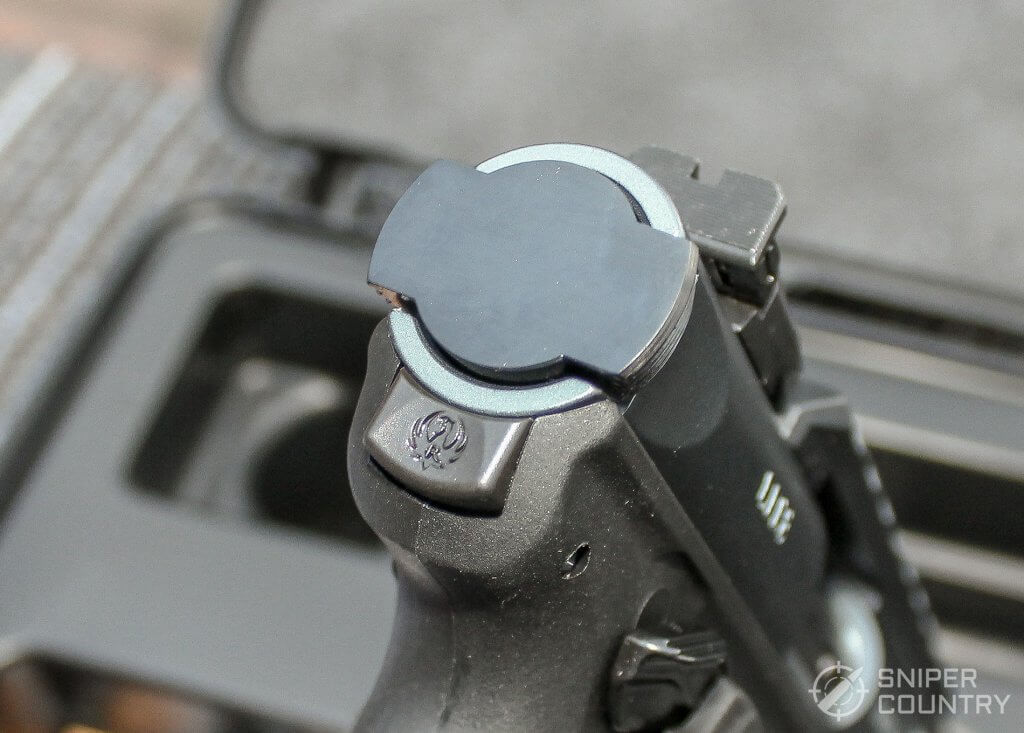
The best upgrade of all as I see came with the Mk IV series, what our sample gun is. All you have to do is press in on the button at the rear bottom of the slide and tilt the barrel down. Remove the barrel and slide, pull the bolt and clean away. It takes longer to describe the process than to do it. I recently bought an S&W Victory .22 pistol that has a pretty simple takedown, it only involves removing one hex-head screw, but it is dripping with complexity when compared to the Mk IV’s one-button-press procedure. In my humble (but experienced) opinion, that is probably the best upgrade Ruger could have done. Let’s face it, they’d already twisted the Standard platform about every which way it could go with barrels, sights, frames, etc. so it only made sense to do something that would make cleaning the gun easier. I can only imagine the number of Ruger pre-Mk-IV rimfires that have not been cleaned much (if any) simply due to the anxiety and frustration caused by taking them apart and not being able to get them back together. I’ve known folks who actually took their pre-MK-IV pistols to a gunsmith to reassemble.
That being said, another upgrade (or feature, depending on how you look at it) is the threaded barrel. Ruger makes it easy to buy a pistol with a suppressor designed for that gun (and its stablemate, the Ruger SR22). If your dealer is set up for suppressor sales (my local one isn’t), you can order both from one company, do the paperwork and you’re done. With that suppressor and the right ammo, this would be one fun gun.
Photo Gallery

I do like Ruger’s new box. It’s very protective. The branding looks like a small, portable billboard.
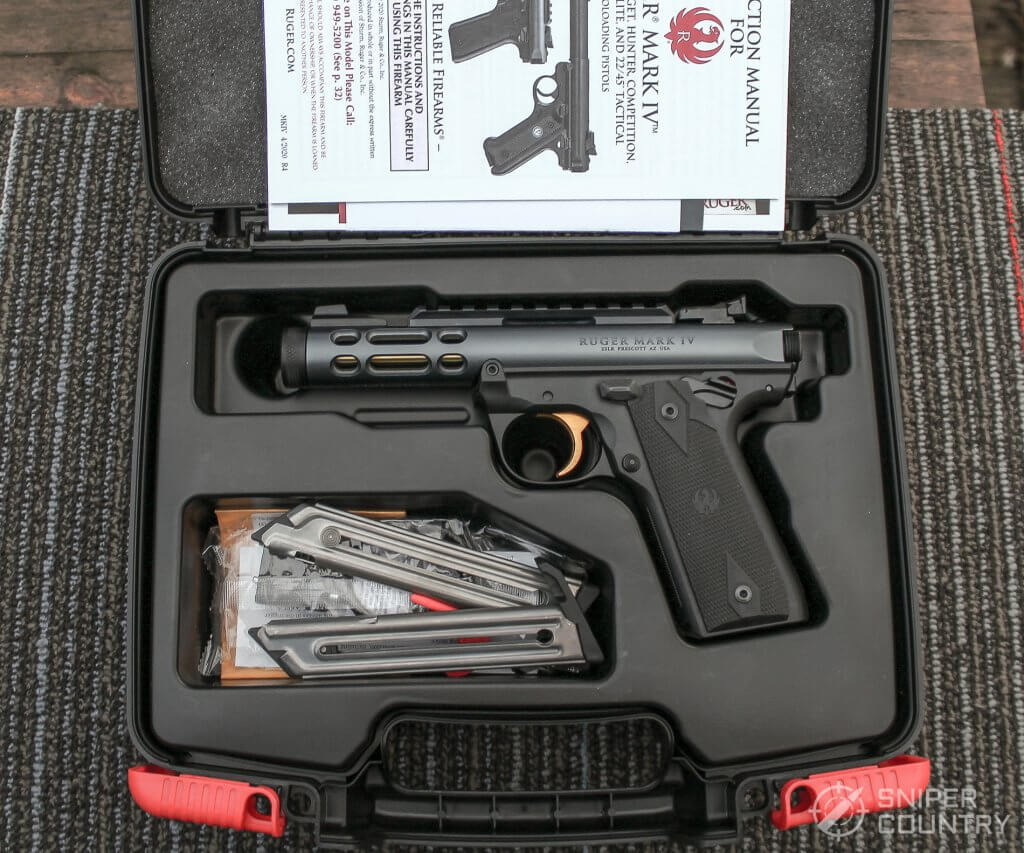
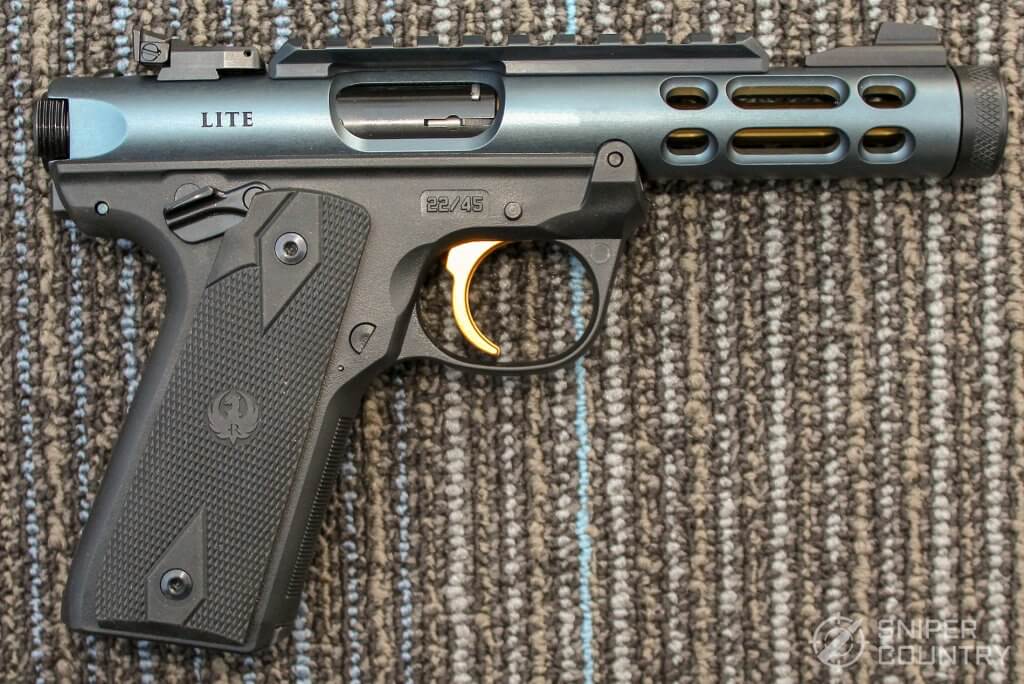
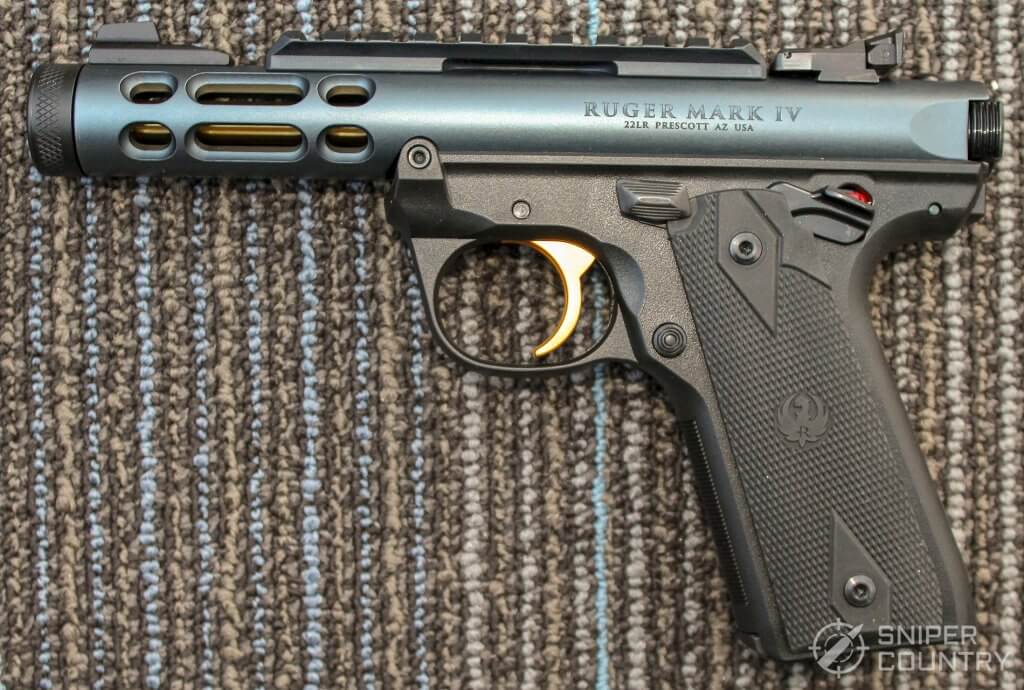

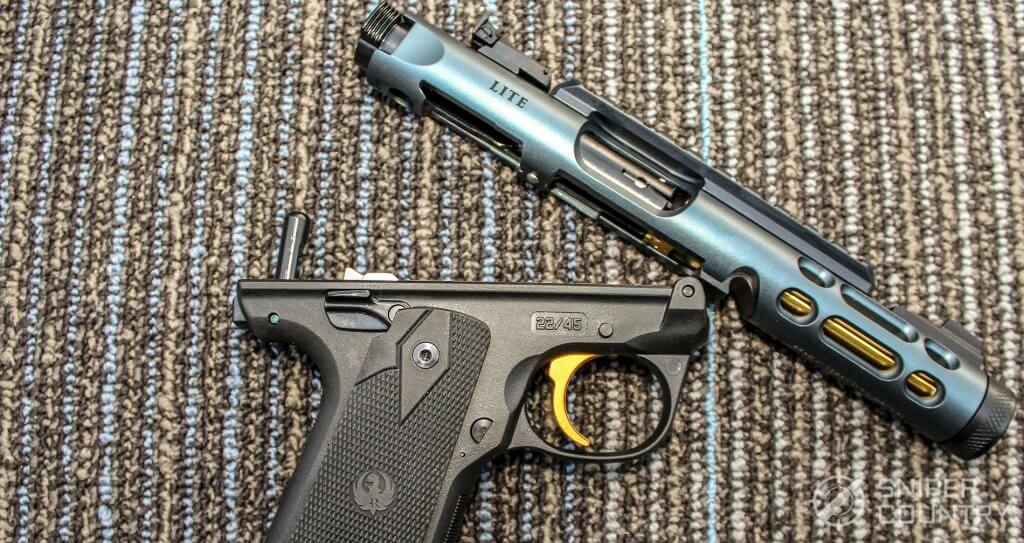
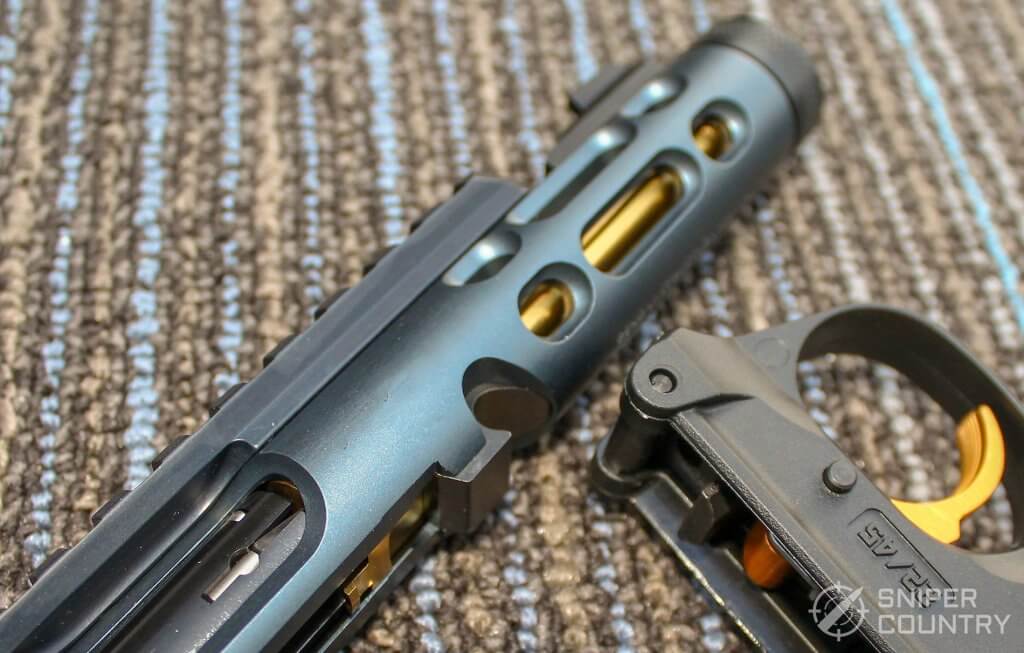


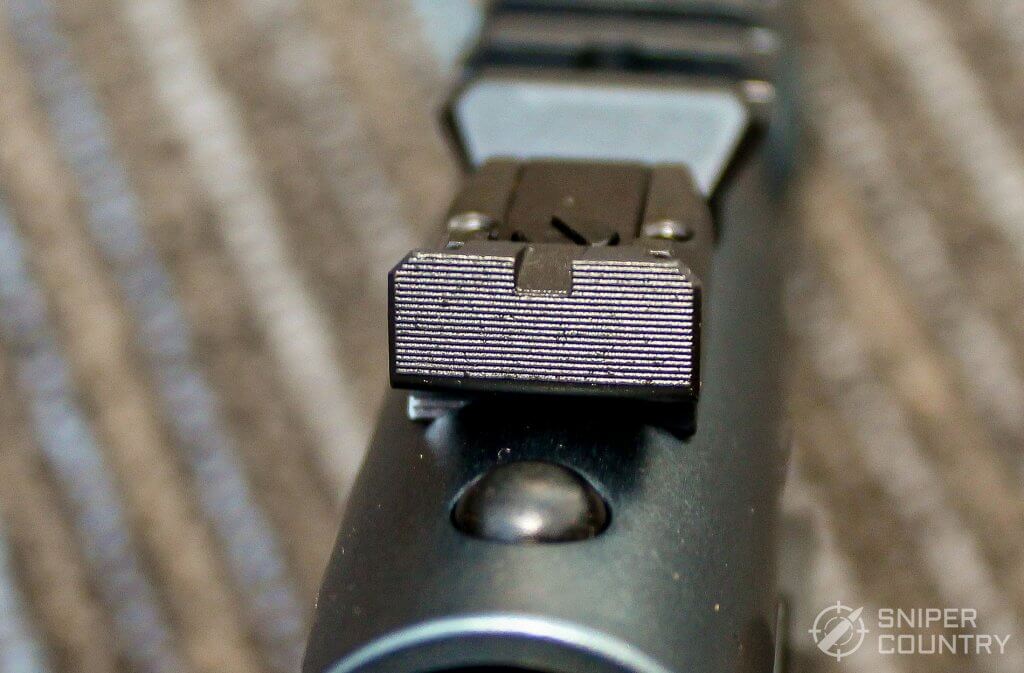
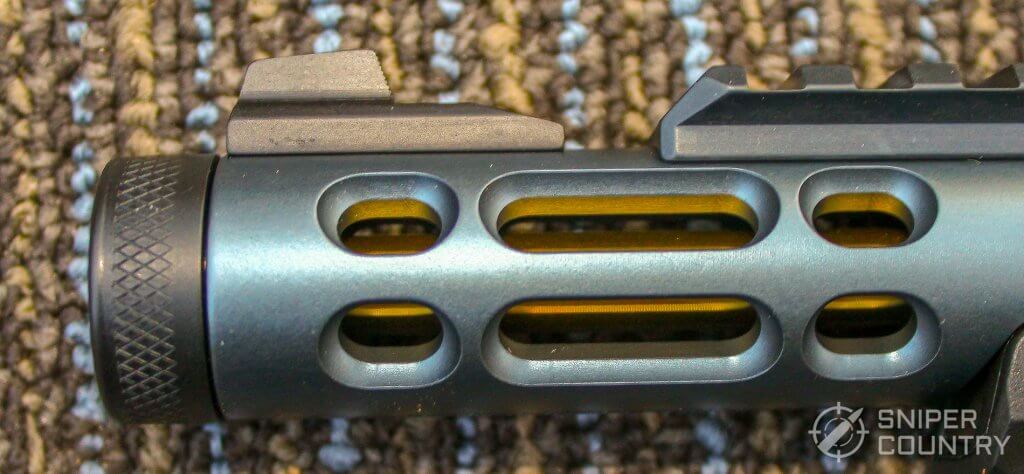
I think these slots helped in producing a pretty big flash with every shot. I could be wrong, the barrel’s not ported, but it was interesting at dusk!
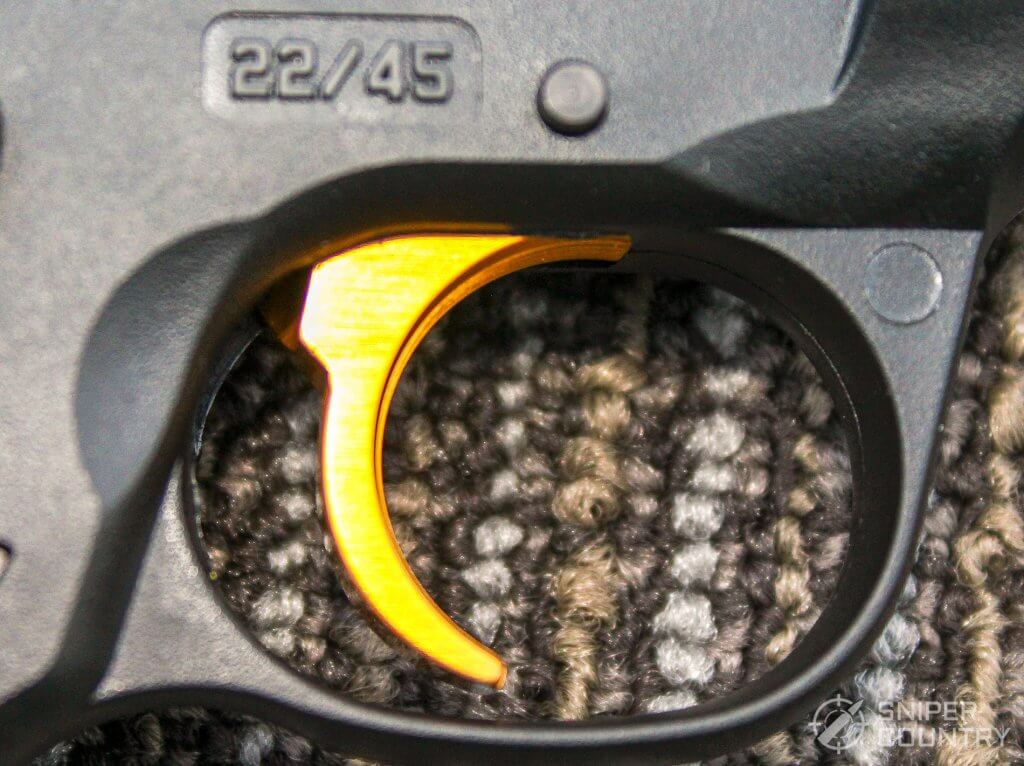


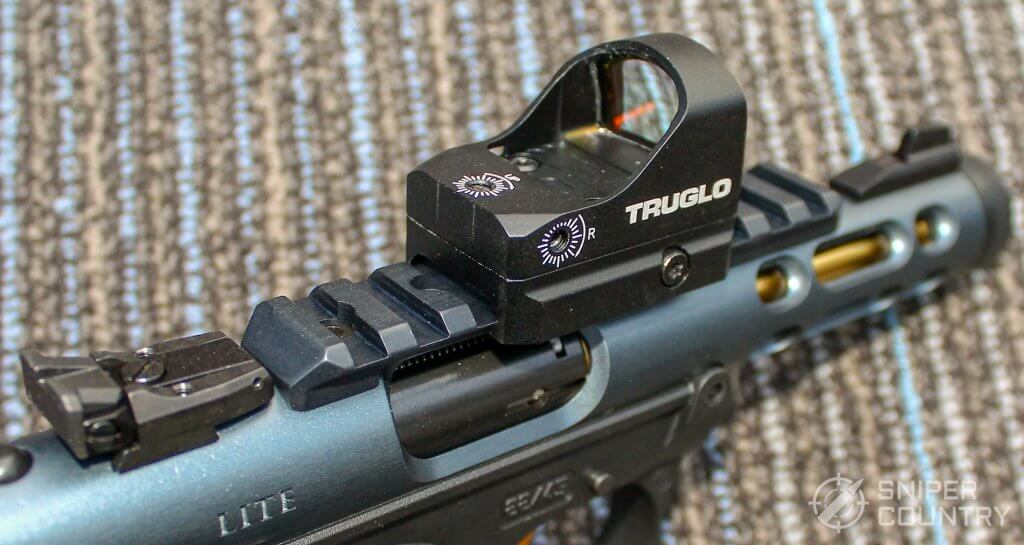

And, for those who are so inclined, stick a red dot on the Picatinny rail.
Specs & Features
| Overall Length: | 8.40" |
| Height: | 5.50" |
| Width: | 1.22" |
| Weight: | 25 oz |
| Capacity: | 10+1; two magazines included |
| Barrel Length: | 4.40" |
| Barrel Style: | Threaded 1/2"-28 |
| Trigger Pull, measured: | 3 lbs., 8 oz. |
| Sights: | Rear adjustable, front fixed |
| Receiver Material: | Aluminum |
| Grip Frame: | Polymer |
| Finish: | Diamond Gray Anodized |
| Warranty: | Lifetime Service |
| MSRP: | $559.00 |
| "Real-World" Price: | ~$480 |
Features
- One-button takedown
- 1911-style checkered grips; 1911 grip angle
- Compatible with Ruger’s Silent-SR supressor
- Picatinny rail for optics options
- Ambi safety can be converted to left side only
Uses For This Short-Barreled .22 Pistol
One area I like to touch on in my reviews of guns concerns usage. We all tend to buy guns to fulfill certain needs, or at least I do. Conversely, I know folks who buy guns just because they were in the gun case and they looked cool…wish I could afford to be that way. For me, a gun needs to be purpose-driven, at least a little. My deer-hunting area is just across the road from our house so I tend to think about guns that would work for that purpose. Never mind the fact that I am not a rabid deer hunter. It’s just nice, thinking that this .44 would make a great deer gun or that .350 Legend would work at the ranges that I typically see deer. Anyway, I tend to do that.
So, what purpose do I see for this .22? Deer hunting. Oh, sorry, got carried away. Actually, if I found the right brand of ammo that it liked and was accurate with, I’d stick a pistol red dot on it and take to the squirrel woods. A gun this size, even with a reasonably-sized red dot sight, wouldn’t take up a lot of room in a backpack. You could find or modify a holster and carry it on your trips to the range, or trips to your grain elevators or fence rows, if you lived in the type of area I do.
We’ve had critters from the neighboring woods and fields visit us from time to time, more often now that we’ve added chickens to the mix. I remember the weasel that one of our cats dispatched. Now, we’ve all seen the Warner Bros. cartoons with the weasel and Foghorn Leghorn but this did not pretend, there was a weasel dead in the yard. That’s the type of critter I alluded to above. Not to mention the coyote symphony we hear coming from close by in the fields across the road, which sure gets your attention. And, many years ago, our oldest son literally jumped out of his sandals when a bobcat cut loose about 15 yards from our woodshed. Would I purposefully go after a coyote, bobcat or any larger predator with a 4-inch-barreled .22? Of course not. It’s just that you never know when one of those critters will make an appearance. I could post, here, the photo I took of two coyotes 108 yards away from our front door but I won’t, you get the point. Sometimes, as in concealed carry, the gun you have with you is way better than the one you left in your nightstand. At least you could scare the thing away.
To sum up uses for this gun, I’d say use it for whatever you desire, that’s legal. It shouldn’t disappoint.
Shooting The 22/45 Lite
The lightweight aluminum frame really helps when you carry this gun around but not so much when you shoot it. Now, I’m not saying that the lighter frame ruins the shooting experience. After all, many shooters enjoy the balance this gun presents in your hand while you shoot it. To me, it seemed like it could be just a bit muzzle-heavy, maybe that’s why they relieve the barrel shroud in front of the trigger guard. That removes a few ounces of weight and helps to stabilize the gun in your hand. Anyway, the gun shot very well.
As with just about every other shooter in the known universe, I can’t find ammo to buy at my local haunts. (Well, at least here on Earth, not sure about Martian ammo supply). If it’s centerfire, I can reload for it. Rimfire, no way. Consequently, I shot just a few loads through our test gun.
Here are some targets I shot. I stuck the red dot sight on the rail but had not adjusted it. It was getting dark and I was in a hurry. So I had to improvise an aiming point at the top center of the target, as the dot was set very high. I was really impressed with the Federal load, even considering the make-do, not-very-precise aiming point. The group is 5 shots, not too bad!

HP this was obviously the most accurate of the three loads I tried.


In terms of the trigger, it had a small amount of creep with little to no take-up. The break was crisp, light, and consistent. That decent trigger helped in the accuracy department, as is evident above. As you can see, the gun should be a winner if its owner has a chance to try several different types of ammo in it and then selects the best of the lot. It sure started out in a good direction. The sights would help, too, if I had used them. I really appreciate having an adjustable rear sight on any kind of .22 handgun, you never know which load you try will be the best, and you need to be able to adjust the sights for it. And, as mentioned elsewhere, I stuck a Tru Glo red dot on it just because I could, the Pic rail made it easy. I find that the red dot I put on my S&W Victory really helps in getting tight groups, my glasses preclude my shooting my best, it seems, with open sights. The trifocal aspect makes it hard to focus on everything that needs to be focused on. Anyway, the red dot helps. If I were to add this to my gun cabinet, it would sport a red dot. Here’s more on that subject.
Red Dots Vs. Open Sights
As I get older, my vision is not what it once was. That is no big surprise, especially to any older shooter. Trying to focus on three focal planes at once, rear sight, front sight, and target, especially with the front and rear as close together as they are on this Ruger .22 are not easy. I know, you don’t really focus on the rear sight, you just center the front sight in it, even so, it’s not what it was. A loyal reader recommended quadfocals, four distinct focus bands in your glasses. That sounds interesting but I have discovered an easier way to get on target, red dot sights. Again, this is not exactly news but I was late to the party. I am retired from teaching and as such have to watch what I spend on my shooting hobby. I finally bought an inexpensive red dot, the $25 variety, that I stuck on my S&W Victory .22. I have, since I’d done that, received another red dot or two for review. These sights are the answer, at least for me. I will take a look at this Tru Glo sight in a future review, suffice it to say, it works. I highly recommend shooters who are on the downward slope of the vision hill to check out red dot sights, as I said above, you can get one that works for around $25. Lasers are good, too, but tend to have more limitations, range, and ambient light being two. They are usually a short-range proposition that tends to work best in darkness or near-darkness. I have one of those on a pistol and like it (especially when the cat comes out and sees the dot on the floor, talk about cheap entertainment!), as it is great for short-range fast shots. This Tru Glo red dot really helped. Anyway, that’s my plug for red dots. I figure anything you can do that helps you as you engage in your hobby is a good thing, and these sights do help me engage in mine.
Using a red dot on this Ruger provides a natural, fun shooting climate and should lead to a lessened ability to put the gun down and go home from the range.
Conclusion
I always like it when I get to the “Conclusion” (or whatever I call it) part of a review. I usually ask the question “what did I think of this (gun)-(sight)-(reloading gizmo)?” Most of the time, I liked whatever it was. That’s not unusual, I tend to review things I like. OK, so how does that apply to our little Ruger 22/45 Lite? I like it. No surprises there. I at least have a basis for comparison, since I’d just bought the S&W Victory a few weeks ago. How does it compare? Well, it’s lighter and smaller (mostly), and as much fun to shoot. I’ve only had one .22 semi-auto pistol out of all the guns I’ve owned over the years that I didn’t like. That gun would not shoot two consecutive .22 rounds without my helping it eject the old case and load the new cartridge. It is essence was a single shot and shall remain nameless. But only one gun out of all those others, not too bad! This Ruger would definitely be on the forefront of rimfire pistols that were ready to be brought into action at a moment’s notice. Its smaller size, balance, accuracy, and style would enable this little gun to be brought to bear quickly. Whether you are racing a hand-held shot timer or trying to get that !@#$% varmint before he gets out of your chicken yard, you would have what you need close at hand. Pop a red dot on the rail and you’ve just added to its usefulness. I do think that this .22 would be a great addition to any gun collection. If you own one, let’s hear from you below. As always, keep ’em in the black and stay safe!

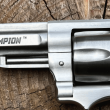
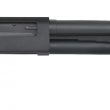
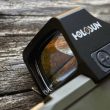



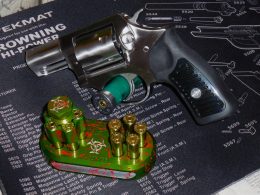
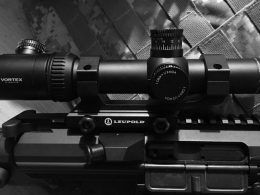

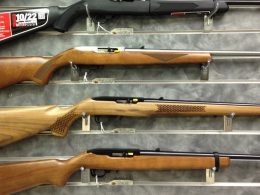

Hi Mike thanks for another informative article, my brother in law has mark IV 22/45 lite I got the opportunity to shoot it and was very impressed, love the feel of the grip felt like my 1911, it shoot great , he has a red dot on it I was not a fan I am used to iron sights, the red dot might take some time to get use to. I have a mark IV target and love it after shooting the 22/45 I think this might be might next purchase. Have a good week.
Marc, the gun is fun to shoot for sure. I was with you on the red dot issue but the more I use one, the more I like it. I appreciate your comments – thanks for writing!
Good review and Ruger history. I’ve shot a few of the various Mark versions, but never owned one. Semi Auto wise, the High Standard Model B and Walther P-22 Target I own means I’ll probably never need to buy one, but who knows if the right deal comes along. So never say never.
Both the Model B and the P-22 are a pain in the patoot to strip down and reassemble (the P-22 Target is definitely not toolless). So from that standpoint, the Mark IV sounds more operator friendly, and that’s a big plus over its previous incarnations. Being Optics ready is a sell point as well. The P-22 requires an extra mount, and there’s no way I’d have a 1932 Model B modified to a accept an Optic (my aging eyes would appreciate it, but only an idiot modifies a vintage gun).
So I’ll have to keep my eyes open for a good deal to come along
Bemused, yeah, that rail on top is really handy. it’s there already – no need to add it. You have a couple of really nice pistols – let us know if you add the Ruger. Thanks for writing again!
How far away from the target were U , when U shot the 22?
Tom, I forgot to mention that I was 15 yards away. I try to do what the NRA does when they test guns – 25 yards for 4-inch-or-longer barrels, 15 (or less) for shorter tubes. Thanks for writing!
Mike you had that right, 3 times with the racoon! I have a mk2 government target I do not shoot as often. I would like to have a mk4 standard 10″ barrel. As always I enjoy your articles and understand the ammo / component issue. We shall see how thus works out in the next year.
Douglas, Yup, the raccoon is essential! Or so I might think sometimes.. I’m with you on the ammo situation – we’l l see. Thanks for writing.
>”If it’s centerfire, I can reload for it. Rimfire, no way.”
Mike, I’ve not ever reloaded rimfire either (though I have snipped the ends off of the bullets of 17 HMR ammo and developed a good method for fire lapping with them, which is another story). I take it you’ve not seen Tom Gaylord’s current series on reloading 22LR. Here’s the latest installment and it contains links to the first three segments. He’s not finished with the series yet either:
https://www.pyramydair.com/blog/2021/01/reloading-22-rimfire-cartridges-part-4/
Tom is known as “The Godfather of Airguns” but he’s really much more. I think he’s The Godfather of Gun Nuts–or at least one of them! 🙂
For obvious reasons, I think 22LR reloading is becoming more popular. Cutting Edge even makes bullets for it:
https://cuttingedgebullets.com/curx-32gr-22lr-bundle-200ct
-Cal
Calin, thank you for educating me – I had not run across him before. I will check it out – thanks again for writing!
Mike,
Years ago I was looking Ruger .22 LRs at a gunshow and eyeballing and then got to handle several of the MK IIIs I think could have been MK IIs Stainless and Bull Barrel they were under $200.00 USD +tax but they just didn’t feel right in my hand for whatever reason so I turned them down….I was an IDIOT!
Oh about that that little Gizmo you saw advertised, It clearly states IT DOE NOT work on the .22/45.
While I do love my Ruger .22/.45 and so did a friend of mine and he had fiber optic front sight that fit it and installed it and WOWSERS! I think they are True Glo but not sure, That is how I found that the Day Glow Green or whatever they call it was the best for me. It had several tubes of various colors that tried. All were good but some were better than others and the Green was the Best of all.
There are ideas of modifications I would like to have done and currently talking with a machinist friend about. If we can make it work and maybe patent it or sell it to Ruger or perhaps to owners that might be interested but so far we are still in the drawing and design phase including fitting.
I will leave that at that for now.
Actually I am not a fan of ultra light firearms or Aluminum frames but they do have their place!
I do have a polymer frame and I have the same concerns about them in centerfire calibers but as far the .22 LR I don’t think there is nowhere near the pressure and stress as with centerfire calibers so not as much wear and tear on the frame. I could be wrong….
But It does seem that the polymer frames do seem to have a life span or something. A few years ago I saw some hard use and was told the frames were worn out or very close to worn out and to leave them alone.
But that left me to wonder how long they will last I know that depends on the rounds put through it and +P rounds will accelerate that wear and tear. I am sure I am not the only one to wonder such.
Back to this model of the .22/45 I don’t care for the barrel sleeve/shroud. All those holes leave space for dirt, debris, ect to accumulate.
I do like the thread for a suppressor …. and the protective cap/nut for it.
Years ago in various Hollywood movies their were Twist on and twist off Suppressors that locked around the Front sight on the bull barrel models.
I don’t know for sure IF such exists in reality or is only a Hollywood prop. I have seen real models the front sight was removed and threaded to allow the suppressor to be attached/mounted.
Bingo, yeah, I should have mentioned that the aftermarket part won’t work on the 22/45 – thanks for pointing that out. I was really impressed with the gun, as (from what I read) others were, too. You’ve sure had some experience with .22 pistols – appreciate your knowledge. Thanks again for writing!
Thanks Mike! Most glad to share what I do know and will admit it if I don’t know or cannot give an answer or solve the problem.
i do enjoy helping people/anyone IF I possibly can.
As for me and .22 LR, I have handled one or two and fired One or Two so far in my Life. LOL back in the 80s and early 90s Walmart would have 550 Loose rounds of Federal .22 LR 40 grain JHP stacked on the counter it varied in price sometimes as low as $4.00 a box to $6.00 to $8.00 4 boxes=2100 rounds from a total of $16.00 to $24.00 up to $32.00, depending on a sale or regular price. Needless to say that was the Good Ole Days….and lots of cheap shooting. and live fire practice..
My 22/45 REALLY LIKES the Remington Hyper Velocity Viper 36 grain truncated cone bullet. I surprised myself with it and the .22/.45 and on a good day it would be close to a one ragged hole at 25 yards. since the ammo shortage and the insane prices for .22LR in some places,,,
I have seen them asking and actually selling .22 LR for $1.00 a round!
I have not seen it on the shelf in years.
BTW I just looked real quick and found them on Midway USA and while normally I WOULD Laugh at the price and walk away.
Now days in this Topsy -Turvy Mixed up World, I must admit the price is not bad.at all.
I might pick some next time I get paid….THAT IS If they have any left in stock.
Check for yourself and let me know what you think of the price.
If you can get some and see how your newest addition handles it!
https://www.midwayusa.com/product/1601169185/
Stay Safe and Healthy and You keep writing and giving us the Good Scoop and interesting articles and I will keep reading them and comment when I can.
Bingo, I did check your link – they are Temporarily Unavailable…figures… Anyway, $14 for 100 hyper-velocity specialty .22 rounds is high but not out of order, given current conditions, Midway seems to be reasonable in their pricing, as far as I’ve seen. I’m always glad to read your comments – keep them coming!
Just inherited a 22 45 Mk II from my father in law. He bought it at a pawn shop in 2000. It was his “boat gun”, so I’ve stripped it down and totally cleaned it. As a former Navy competitive shooter, I’m familiar with Ruger target pistols and am looking forward putting this one to the test. I wondered what the 22 45 designation meant! The 1911 style grip is intriguing, and thinking back to 3 gun shoots, the transition from the .45 to the .22 would have been very smooth and with better scores on the board with the 22 45. Thanks for a very informative article. You really do learn something new every day!!
During the Vietnam War, many pilots were issued S&W .38 revolvers. In 1975 following the fall of Saigon, during the refugee evacuations, as a military customs inspector processing the refugees through Guam, I recovered a Mod 10-5 J frame 2″ barrel .38 from a Vietnamese refugee. It and several other recovered weapons, including a British Webley, were placed in the Customs Division safe. Sometime in May, 1975 we were advised that all military equipment and weapons had been stricken from the records, and I was presented with the above revolver. A local gun shop sent it back to S&W, where it was magnafluxed, re-blued and returned with a clean bill of health (and the original checkered wood grips). My bill was $25!! Uncomplicated and dependable, it has become my go-to EDC.
Several .380’s in the collection: A 1908 Colt Hammerless that was issued to my dad by the Navy during WW II and which he carried until his passing in 1995. A RIA “Baby Rock” 1911 .380 that is an awesome performing compact and great EDC, and a PK-380 that my wife keeps in her purse. All capable of getting the job done, but as with any firearm, range time and scenario drills should be a regular part of life – just in case
Navy Shooter, wow – really intriguing! They just gave you the gun, huh? Interesting! As for that Model 10, you sure can’t do better in a .38 revolver. I bet you enjoy shooting it. Thanks again for writing!
Well Mike, you just sold a Ruger MkIV – sight unseen! I appreciate your articles and your coverage, keep it up!
Charles, I’m Ruger would appreciate that… it’s a very nice gun. Thanks for the kind comments. Thanks for writing!
I took apart one of those older versions and had to take it to a gunsmith to get it back together. I will never, ever do that again. This new one looks like a vast improvement.
Bert, welcome to the club! I feel your pain. Thanks again for writing.
I own a Mark II, III and 2 Mark IV;s, including the Lite. Keep in mind that threaded barrel will take a flash hider. Yes, the older Marks are harder to reassemble, but depends on your mechanical ability. Friend of mine got a Mark I that was his fathers and it had been apart for nearly 50 years before I went all over it for him; even the magazine was worn out. Complete cleaning a a new mag make it work like new.. With a red dot on a Mark III Hunter I can knock off spent 12 gauge hulls from 25 yards. CCI AR Tactical is an extremely accurate load in the Mark IV Lite; also had real good results with the Federal CHP as you did. The Hammer Strut Support does make it easier to work on the older Mark’s, but does not fir the 22/45 configuration. Replaced the front sight on my Lite with a HiViz fiber optic, a good upgrade. Love my Rugers, anxious to see them making the Marlin lever guns later this year, due in second half.
Just Me, you surely have had a lot of experience with Ruger rimfires. Interesting that you got that gun put back together after 50 years – I’ll bet your friend was glad! Thanks for writing – appreciate you sharing your knowledge.
Did you get the info you asked for on making a front sight enhancement on single action fixed blade sights made from a 22 shell casing?
Yep, just haven’t had a chance to do anything with it. I appreciate you sending it – looks interesting!
May not be the neatest looking fix, but as far as being able to accurately hit things it works great. Sure works easier over varied distances; just learn your hold for the amount of blade for that distance. Experimentation is part of the fun and this is totally reversible with no damage to the gun.
Just Me, I’ll have to try that. Thanks for writing again!